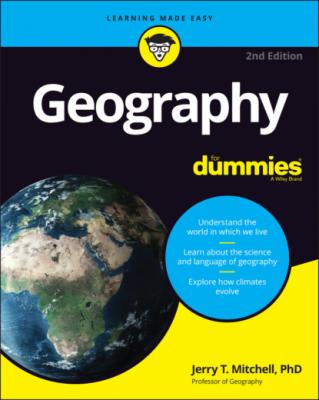ТОП просматриваемых книг сайта:
Geography For Dummies. Jerry T. Mitchell
Читать онлайн.Название Geography For Dummies
Год выпуска 0
isbn 9781119867142
Автор произведения Jerry T. Mitchell
Жанр География
Издательство John Wiley & Sons Limited
Every line of longitude is a great circle — a line which, if continued around the world, would divide Earth equally in half.
Graticule
But more important than saying “graticule” is the ability to use it properly. That means, among other things, correctly identifying the grid coordinates (latitude and longitude) of locations indicated on a map. With that in mind, take a look at Figure 3-3, which represents a portion of the graticule. Note that lines of longitude are shown parallel (when in reality they converge toward the poles) and that only every tenth degree-line of latitude and longitude are indicated. World maps typically “skip” lines in a similar fashion, lest they become cluttered by the graticule. But what I really want you to focus on are the three dots lettered A, B, and C. See if you correctly can identify the coordinates of each dot, keeping in mind the following rules:
1 When reporting coordinate locations, always give the latitude first, and then give the longitude. (Why? Because latitude comes first alphabetically? Because latitude was accurately measured before longitude? It doesn’t really matter. It’s just the rule and the system only works if everyone uses it the same way.)
2 Correct reference to latitude must specify whether a location is north or south of the equator (Latitude 0°), assuming the location is not on the equator itself.
3 Correct reference to longitude must specify whether a location is east or west of the Prime Meridian (Longitude 0°).
(© John Wiley & Sons Inc.)
FIGURE 3-3: A representation of a portion of Earth’s grid.
The correct locations of the dots are as follows:
| A | = Latitude 20° North, Longitude 10° West |
| B | = Latitude 5° South, Longitude 20° East |
| C | = Latitude 22° South, Longitude 17° West° |
Minutes and seconds that don’t tick away
On Earth’s surface, adjacent lines of latitude and longitude may be several miles apart, and that creates a potential problem if you wish to state the absolute location of a spot that is “between the lines.” For this reason, the graticule contains a couple of levels of refinement (see Figure 3-4).
(© John Wiley & Sons Inc.)
FIGURE 3-4: Degrees, minutes, and seconds.
First, the space between successive degree lines may be subdivided into 60 equidistant units called minutes ('). Second, the space between successive minute lines may be subdivided into 60 equidistant units called seconds ("). And if more exactitude is needed, then seconds may be carried out to as many decimal points as may be necessary.
Doesn’t this sound familiar? Sixty seconds in a minute? And for good reason. The system that you use to tell time goes back to the same Sumerian base-6 arithmetic that Hipparchus used to divide up a circle and also the world. Hmmm … there are 24 hours in a day. Think 24 being evenly divisible by 6 is just a coincidence? No way.
Chapter 4
Truthiness in Mapping
IN THIS CHAPTER
Imagine a million-dollar map contest. The only thing you have to do to win is to supply an exact map of the entire Earth that’s flat. Here’s how to enter!
1 Get your hands on a globe.
2 Peel off the surface layer in such a way that you end up with one big piece of map peel. (You may want to use somebody else’s globe because this procedure results in the globe’s complete ruin.)
3 Lay the map peel on a flat surface so that the two surfaces are completely in contact but without distorting the original map in any way. You can cut the map if you want, but pulling and stretching it is prohibited.
You are absolutely right if you think it’s going to be tough to submit a winning entry. Actually, it’s impossible. You can’t take a sphere-like surface (see the sidebar “Earth’s shape: Sphere-like, not spherical” for more on this), such as Earth, and lay it down flat without distorting the original image. This fact, however, hasn’t deterred people from making flat maps of the world or parts thereof. And, to do that, the mapmaker has to figuratively pull it here and stretch it there. The result is a map that’s full of distortion. Full of distortion? Well, simply put: Maps that lie flat lie!
EARTH’S SHAPE: SPHERE-LIKE, NOT SPHERICAL
People often say that Earth is a sphere. Not so. By definition, a sphere is a curved solid whose surface is always the same distance from its center, no matter at what point of the surface. Technically, Earth doesn’t fit that definition. Instead, Earth is an oblate spheroid, meaning it is somewhat flattened at its poles, or, if you prefer, it bulges somewhat around the Equator. The average distance from Earth’s center to the Equator is about 26 miles farther than the average distance from Earth’s center to the poles. Compared to the size of Earth, 26 miles isn’t a great distance, but it’s enough to make Earth not a real sphere. It’s better to say Earth is sphere-like, or an oblate spheroid.
Earth’s rotation causes its oblate-ness. The speed of Earth’s rotation is much faster at the Equator than near the Poles. This difference in speed may not be obvious, so think of it this way. Earth’s circumference measured along the Equator is about 25,000 miles. If you stand at a spot on the Equator for one day — for one full rotation — you’ll travel 25,000 miles. In contrast, if you stand a foot or two from the North Pole for one rotation, you’ll only travel a few yards. Obviously, somebody who travels 25,000 miles in one day is moving much faster than somebody who travels a few yards in the same

